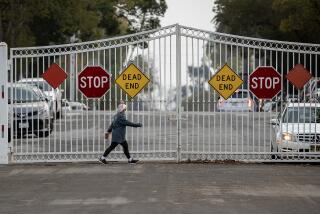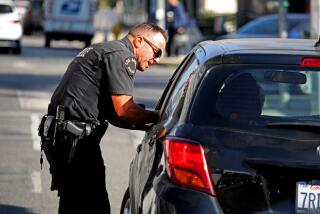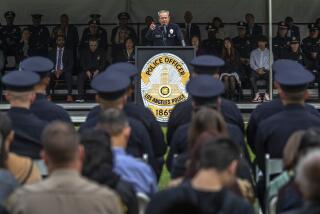Does Echo Park need a gang injunction?
Los Angeles has 45 gang injunctions. Does it need one more?
Gang injunctions restrict the actions of people associated with street gangs within designated zones. They bar two or more from gathering and add civil penalties to acts that already are crimes, such as tagging and public drunkenness, on the theory that such limitations undercut a gang’s ability to control the streets. Los Angeles began imposing injunctions in the 1980s.
Echo Park has a history of gangs dating back at least to the 1920s, and in more recent decades six gangs were involved in violence, drug dealing and other illegal activities that harassed neighbors and undermined the quality of life in the community. Residents say that the worst of times was the 1990s and that since then, the area has gradually improved. They can, and do, argue over the reason for that improvement: the most violent gang members were prosecuted and sent to prison; the area became gentrified by young professionals and artists unconnected to the history of neighborhood rivalries; or the culture of gang violence petered out, even though the suspicions and loyalties remain and violent crimes still occur.
Backers of an injunction in a “safe zone” in Echo Park known as the Glendale Boulevard Corridor argue that the injunction is needed to consolidate gains and to nip out the remaining problems, and to prevent the area’s relapse into chaos as imprisoned gang members complete their terms and return to their old neighborhood and, perhaps, their old ways. They argue that new City Atty. Mike Feuer is right to continue the court process, begun by his predecessor in the waning days of his term, to put an Echo Park gang injunction in place.
Critics point out that Echo Park is well past its gang emergency days and argue that an injunction, if it was ever appropriate, would be 15 years too late. Some assert that an injunction would serve to harass longtime residents, preventing, for example, two brothers who may have tenuous connections to a gang and haven’t been charged with any specific crime from sitting together on their own front steps.
In pursuing the injunction, Feuer has a more complete and more enlightened approach than did previous city attorneys. He seems to recognize that although they are intended to protect neighborhoods, gang injunctions also ensnare thousands of the city’s young men and their families in a cycle of failure. For example, in addition to barring two or more members of a designated street gang from gathering in public, and in addition to allowing city lawyers to seek civil penalties for illegal behavior (with evidence that can fall short of the strict criminal law standard of proof), injunctions flag people — often for life — as gang members and make it harder for most to get decent jobs with advancement opportunities or to seek higher education. And, some assert, they don’t do it all that accurately, occasionally including a person who fits a demographic profile or who may be friends with or related to gang members without being one.
There is a procedure for an individual to be removed from the gang injunction list, but it is little known among those named. Being included in a gang injunction usually results in the individual being put into a statewide gang database, from which there is no exit process.
If there is a toolbox for dealing with gang and crime problems, a gang injunction is a sledgehammer. Feuer proposes to also use more constructive tools. He wants to ensure that the people — almost always young men — who become subject to the injunction’s restrictions on behavior have a clear and understandable procedure for clearing themselves if they were put on the list improperly or when they can show that they have severed their gang ties. And, importantly, he wants to make sure that restrictions automatically expire for each of the individuals named after five years; he and his successors would have to go to court with new evidence if they want to keep a name on the list beyond that point. Together with the Advancement Project, which has been behind much of Los Angeles’ best work to prevent young people from joining gangs and to help those already in them move toward more constructive behavior, Feuer has crafted a program for outreach to help people understand what to do to get off the list and to help them with the applications.
These are smart ideas that make an Echo Park injunction more palatable. The problem with Feuer’s approach is that it lays out a better case for fixing the network of injunctions that Los Angeles already has than for moving forward with a new one.
The situation in Echo Park falls well short of the sort of crime emergencies that led Los Angeles, and then other cities, down the path of gang injunctions 30 years ago. Then, there was at least the perception among city lawyers and police that entire neighborhoods had become hostages to gangs and that there was little else they could do about it. But court pleadings in favor of the new injunction fail to specify any particular crimes or to include figures that show Echo Park has more of a gang problem than other neighborhoods in or outside an injunction zone. Nor do they make an argument for why the situation could not be handled by traditional crime-fighting methods or show that the benefits of an injunction would outweigh the negative consequences for so much of the community.
City officials have obtained injunctions that now cover 74 gangs. Tens of thousands of city residents are potentially subject to the restrictions, but so far about 7,000 have been named and served with notices that they are enjoined. Once the injunction is imposed, it is permanent. If named, a person must complete a cumbersome application and examination process, and meet with the city attorney’s approval, to be removed.
To date, 82 people have sought removal. Of those, 21 learned they were never covered. Only 10 of the 7,000 have actually been removed — a dismal rate for freeing people from the restrictions injunctions impose.
Feuer also proposes to go through, person by person, the entire list of people covered by gang injunctions to determine whether they should still be there. It’s a welcome plan. But he should do that anyway, without adding to the list one more community, and hundreds more people, who could benefit from more constructive ways of dealing with destructive behavior.
More to Read
A cure for the common opinion
Get thought-provoking perspectives with our weekly newsletter.
You may occasionally receive promotional content from the Los Angeles Times.






